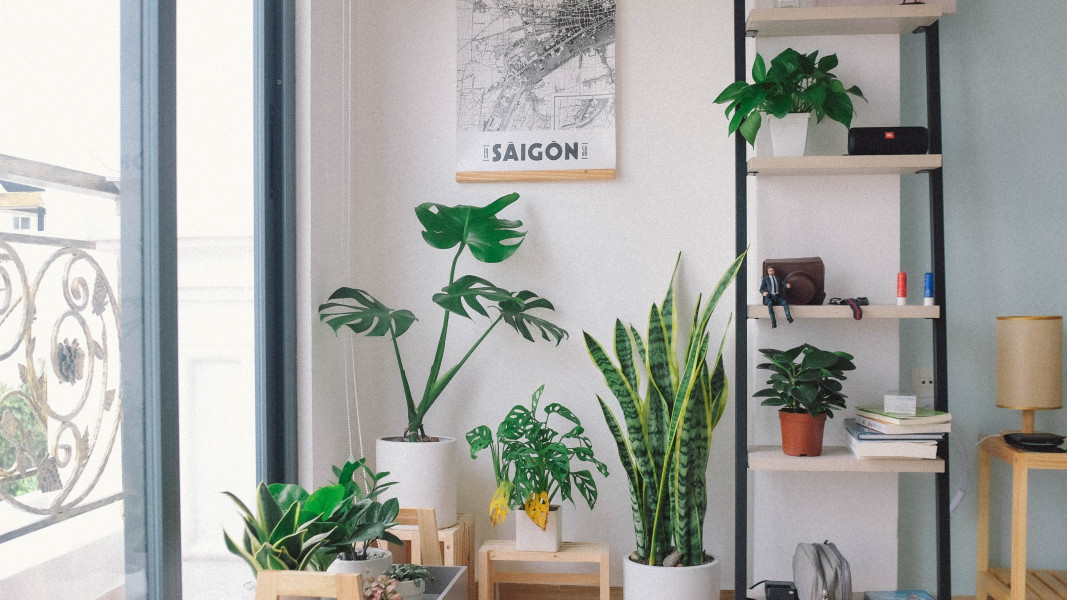Flowers And Plants Indoors
If you meet their basic needs of light, water, nutrients and warmth,
houseplants are easy to grow. Light is very important. If your plants are weak and stretched, it means that they are not getting enough light - provide them with more: it is their only source of energy. Plants need water, but not so much that it drowns their roots. Almost all tolerate drought better than being submerged in water, so be careful not to overwater. Regular fertilizing has a big effect, as nutrients in the soil can be depleted. Temperature often doesn't really matter - if it's right for you, it's probably right for the plants.
Where to put the plant?
The best way to ensure that the plant will be healthy and grow well is to meet its needs for a suitable place in the home. The plant may look beautiful in a certain place, but if the light and temperature are inappropriate, and if you fail to meet its other needs - for example, good humidity, it will soon lose its beauty and take on an increasingly unhealthy appearance!
Clean the leaves of the flowers so that they absorb maximum amounts of light. Use a soft damp cloth to remove dirt or wash with a lukewarm shower.
Fertilizing and watering
Improper watering is the most common cause of untimely death of many houseplants, but if you don't provide them enough, they die.
When to water?
Some plants dry out more quickly than others, so keep an eye on them. Large plants with thick leaves and those that are in direct sunlight typically do this the quickest. Clay-potted plants dry out more quickly than plastic-potted plants. Refrain from watering just because you have the watering can out. Only water the plants when necessary; most are ready when the top 0,5 inches of soil begin to dry up.
Overhead Watering: This is often the most convenient way to water. It is suitable for most plants and especially for those with wooden stems. Thus, we ensure uniform wetting of the soil, as gravity pulls the water down.
Make sure the soil reaches 1-2 inches below the edge of the pot - this leaves enough room for a good watering and you won't have to wait for it to soak. Do not leave the plants flooded with excess water.
Watering from below
Plants with twining or fleshy stems such as African violets (Saintpaulia) tend to die if the plant becomes wet. Therefore, it is important to water these plants from below. You can also use this method to feed with liquid fertilizer. If the bottom of the pot has a layer of drainage, you will need to use a deep dish to make sure that the water reaches the roots. Most plants need soaking for about 20 minutes.
Soak and drain
Orchids are grown in loose soil and it is often difficult to tell if they need watering. Be careful with them as they are damaged by overwatering. A rule of thumb is to soak them once a week in a bowl of cool water. This allows the soil to absorb exactly the amount of water it needs.
Fertilization
Regular fertilization is very important for plants. Start a few weeks after you buy the plant. You can mix the soil with food additives, gradually releasing the substances contained in them, you can also add liquid fertilizer to the water with which you water at regular intervals. Balanced liquid fertilizer, stronger or weaker, is sufficient for most plants. There are also special fertilizers for the specific needs of orchids, citrus fruits, lime-intolerant plants and foliage plants. Liquid fertilizers are very simple to use. Measure the required amount of water, add a few drops of fertilizer and water with a jug or watering can.
Watering problems that might occur
Watering seems to cause more trouble than we might imagine.
Drought is pretty obvious because the soil is dry, but stunting due to overwatering is more insidious: constantly wet soil slowly destroys the roots. With proper care, overwatered plants can be revived.
Drying of plants
If you find that you have overwatered the plant, you may be able to dry it out. Remove the pot and wrap the rhizome with paper towels or newspaper until all excess moisture is drawn from the soil. Then keep it very slightly moist and out of direct sun for a few weeks while the roots recover.
Reviving a stunted plant!
The effect of a drought could be quite dramatic. The plant can suddenly go dormant overnight and in the morning you can see it with limp stems hanging sadly over the side of the pot. Soil that is too dry recedes past it if you try to rehydrate it through normal watering.
1. If the plant sprouts, before you do anything, make sure the problem is dry soil. Flowering can also be caused by overwatering or aphids.
2. Move the plant to a cool place, out of direct sunlight, and place the plastic pot in a bowl of cool water. If the rhizome is so dry that it floats, press it with a stone placed on the surface of the soil.
3. After soaking for about 20 minutes, remove from the bowl and let the pot drain for 10 minutes before returning it to the pot. The plant should show signs of revival within an hour or so.
Watering during the rest period
Water them well before you leave and move them to a cool room out of the sun. If you are comfortable, put all the plants in a tub and water them there.
A capillary watering system is easy to set up and, depending on its size, can provide enough water for plants for about a week. Put a stopper and place a special capillary pad (or terry cloth) on the draining rack in the kitchen and on the sink itself. Place the plants on the mat laid over the colander. The moisture climbs up the substrate and spreads under the pots, where it is absorbed by the soil. This method is not suitable for pots with drainage materials in the base, as the substrate must be in contact with the soil - and of course, you must remove all pots. If possible, do a one-day test - this will allow you to estimate how long it will take to fill a sink with water and check that the stopper is not leaking.
A wick system may be sufficient for plants too large to move. Place a bowl of water above the soil level, press on the bottom and with the help of a stone, a strip of capillary mat (or woolen thread) and bury the other end in the soil.
Create a large reservoir for water to drip into the soil through a hole in the cap of a cut-bottom plastic bottle. A very small hole in the cap is required. It's wise to experiment first before you go.
We guarantee you that following these steps, you will have a magnificent mini garden in your house with healthy and pretty indoor plants!

